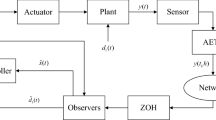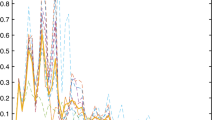Abstract
This paper deals with the event-based finite-time H∞ control problem of discrete-time network control systems with norm bounded input disturbances and nonlinear stochastic functions. A network-induced delay stochastic model is first constructed by event-triggered approach. Utilizing stochastic analysis and event-triggered schemes, conditions on stochastic finite-time (FT) boundedness and stochastic H∞ FT boundedness are then derived for the network model. Subsequently, an event-based finite-time controller and an event-triggered matrix are co-designed to ensure that the stochastic model is stochastically FT bounded or stochastically H∞ FT bounded by utilizing matrix decomposition scheme. All derived criteria can be solved in terms of convex optimal method, and numerical examples demonstrate the validity of obtained results as well.
Similar content being viewed by others
References
W. Zhang, M. S. Branicky, and S. M. Phillips, “Stability of networked control systems,” IEEE Control Systems, vol. 21, no. 1, pp. 84–99, Feb. 2001.
W. Qi, G. Zong, and H. R. Karimi, “ℒ∞ control for positive delay systems with semi-Markov process and application to a communication network model,” IEEE Transactions on Industrial Electronics, vol. 66, no. 3, pp. 2081–2091, Mar. 2019.
S. He, H. Fang, M. Zhang, F. Liu, and Z. Ding, “Adaptive optimal control for a class of nonlinear systems: The online policy iteration approach,” IEEE Transactions on Neural Networks and Learning Systems, vol. 31, no. 2, pp. 549–558, 2020.
R. W. Brockett and D. Liberzon, “Quantized feedback stabilization of linear systems,” IEEE Transactions on Automatic Control, vol. 45, no. 7, pp. 1279–1289, Jul. 2000.
Y. Men, X. Huang, Z. Wang, H. Shen, and B. Chen, “Quantized asynchronous dissipative state estimation of jumping neural networks subject to occurring randomly sensor saturations,” Neurocomputing, vol. 291, pp. 207–214, May 2018.
D. Zhao, T. Dong, and W. Hu, “Event-triggered consensus of discrete-time second-order multi-agent network,” International Journal of Control, Automation and Systems, vol. 16, no. 1, pp. 87–96, Feb. 2018.
Z. Tang, “Event-triggered consensus of linear discrete-time multi-agent systems with time-varying topology,” International Journal of Control, Automation and Systems, vol. 16, no. 3, pp. 1179–1185, Apr. 2018.
K. Huang, V. K. Lau, and D. Kim, “Event-driven optimal feedback control for multiantenna beamforming,” IEEE Transactions on Signal Processing, vol. 58, no. 6, pp. 3298–3312, Jun. 2010.
M. C. F. Donkers and W. P. M. H. Heemels, “Output-based event-triggered control with guaranteed L∞-gain and improved and decentralised eventtriggering,” IEEE Transactions on Automatic Control, vol. 57, no. 6, pp. 1362–1376, Jun. 2012.
A. Selivanov and E. Fridman, “Event-triggered H∞ control: a switching approach,” IEEE Transactions on Automatic Control, vol. 61, no. 10, 3221–3226, Oct. 2016.
J. Cheng, C. K. Ahn, H. R. Karimi, J. Cao, and W. Qi, “An event-based asynchronous approach to Markov jump systems with hidden mode detections and missing measurements,” IEEE Transactions on Systems, Man, and Cybernetics: Systems, vol. 49, no. 9, pp. 1749–1758, Sept. 2019.
Y. Wang, P. Shi, C. C. Lim, and Y. Liu, “Event-triggered fault detection filter design for a continuous-time networked control system,” IEEE Transactions on Cybernetics, vol. 46, no. 12, pp. 3414–3426, Dec. 2016.
Y. Wang, C. C. Lim, and P. Shi, “Adaptively adjusted event-triggering mechanism on fault detection for networked control systems,” IEEE Transactions on Cybernetics, vol. 47, no. 8, pp. 2299–2311, Aug. 2017.
D. Xu, X. Song, B. Jiang, W. Yang, and W. Yan, “Datadriven sliding mode control for MIMO systems and its application on linear induction motors,” International Journal of Control, Automation and Systems, vol. 17, no. 7, pp. 1717–1725, Jul. 2019.
Y. Zhang, P. Shi, and R. K. Agarwal, “Event-based dissipative analysis for discrete time-delay singular stochastic systems,” International Journal of Robust and Nonlinear Control, vol. 28, no. 18, pp. 6106–6121, Dec. 2018.
Z. Hu, P. Shi, L. Wu, and C. K. Ahn, “Event-based distributed filtering approach to nonlinear stochastic systems over sensor networks,” International Journal of Control, Automation and Systems, vol. 17, no. 4, pp. 896–906, Apr. 2019.
L. Weiss and E. F. Infante, “Finite time stability under perturbing forces and on product spaces,” IEEE Transactions on Automatic Control, vol. 12, no. 1, pp. 54–59, Jan. 1967.
F. Amato, M. Ariola, and P. Dorato, “Finite-time control of linear systems subject to parametric uncertainties and disturbances,” Automatica, vol. 37, no. 9, pp. 1459–1463, Sept. 2001.
F. Amato, M. Ariola, and C. Cosentino, “Finite-time control of discrete-time linear systems: analysis and design conditions,” Automatica, vol. 46, no. 5, pp. 919–924, May 2010.
L. Li, Q. Zhang, and B. Zhu, “Fuzzy stochastic optimal guaranteed cost control of bio-economic singular Markovian jump systems,” IEEE Transactions on Cybernetics, vol. 45, no. 11, pp. 2512–2521, Nov. 2015.
G. Zong and H. Ren, “Guaranteed cost finite-time control for semi-Markov jump systems with event-triggered scheme and quantization input,” International Journal of Robust and Nonlinear Control, vol. 29, no. 15, pp. 5251–5273, 2019.
Y. Ma, X. Jia, and D. Liu, “Robust finite-time H∞ control for discrete-time singular Markovian jump systems with time-varying delay and actuator saturation,” Applied Mathematics and Computation, vol. 286, pp. 213–227, Aug. 2016.
M. S. Ali, K. Meenakshi, and N. Gunasekaran, “Finite-time H∞ boundedness of discrete-time neural networks norm-bounded disturbances with time-varying delay,” International Journal of Control, Automation and Systems, vol. 15, no. 6, pp. 2681–2689, Dec. 2017.
C. Ren, R. Nie, and S. He, “Finite-time positiveness and distributed control of Lipschitz nonlinear multi-agent systems,” Journal of the Franklin Institute, vol. 356, no. 15, pp. 8080–8092, 2019.
C. Ren and S. He, “Finite-time stabilization for positive Markovian jumping neural networks,” Applied Mathematics and Computation, vol. 365, Article 124631, Jan. 2020.
Y. Zhang, Y. Shi, and P. Shi, “Resilient and robust finite-time H∞ control for uncertain discrete-time jump nonlinear systems,” Applied Mathematical Modelling, vol. 49, pp. 612–629, Sept. 2017.
S. He, Q. Ai, C. Ren, J. Dong, and F. Liu, “Finite-time resilient controller design of a class of uncertain nonlinear systems with time-delays under asynchronous a witching,” IEEE Transactions on Systems, Man, and Cybernetics: Systems, vol. 49, no. 2, pp. 281–286, Feb. 2019.
Z. Wang, L. Shen, J. Xia, H. Shen, and J. Wang, “Finite-time non-fragile l2-l∞ control for jumping stochastic systems subject to input constraints via an event-triggered mechanism,” Journal of the Franklin Institute, vol. 355, no. 14, pp. 6371–6389, sept. 2018.
H. Shen, M. Xing, S. Huo, Z. G. Wu, and J. H. Park, “Finite-time H∞ asynchronous state estimation for discrete-time fuzzy Markov jump neural networks with uncertain measurements,” Fuzzy Sets and Systems, vol. 356, pp. 113–128, Feb. 2019.
Y. Zhang, P. Shi, S. K. Nguang, and H. R. Karimi, “Observer-based finite-time fuzzy H∞ control for discrete-time systems with stochastic jumps and time-delays,” Signal Processing, vol. 97, pp. 252–261, Apr. 2014.
Y. Zhang, P. Shi, and S. K. Nguang, “Observer-based finite-time H∞ control for discrete singular stochastic systems,” Applied Mathematics Letters, vol. 38, pp. 115–121, Dec. 2014.
H. Ren, G. Zong, and H. R. Karimi, “Asynchronous finite-time filtering of networked switched systems and its application: an event-driven method,” IEEE Transactions on Circuits and Systems-I: Regular Papers, vol. 66, no. 1, pp. 391–402, Jan. 2019.
Y. Ma and Y. Liu, “Finite-time H∞ sliding mode control for uncertain singular stochastic system with actuator faults and bounded transition probabilities,” Nonlinear Analysis: Hybrid Systems, vol. 33, pp. 52–75, Aug. 2019.
H. Ren, G. Zong, and H. R. Karimi, “Asynchronous finite-time filtering of Markov jump nonlinear systems and its applications,” IEEE Transactions on Systems, Man and Cybernetics: Systems, 2019. DOI: https://doi.org/10.1109/TSMC.2019.2899733
H. Shen, F. Li, H. Yan, H. R. Karimi, and H. K. Lam, “Finite-time event-triggered H∞ control for T-S fuzzy Markov jump systems,” IEEE Transactions on Fuzzy Systems, vol. 26, no. 5, pp. 3122–3135, Oct. 2018.
H. Ren, G. Zong, and T. Li, “Event-triggered finite-time control for networked switched linear systems with asynchronous switching,” IEEE Transactions on Systems, Man, and Cybernetics: Systems, vol. 48, no. 11, pp. 1874–1884, Nov. 2018.
Y. Qi and M. Cao, “Finite-time boundedness and stabilisation of switched linear systems using event-triggered controllers,” IET Control Theory & Applications, vol. 11, no. 18, pp. 3240–3248, Dec. 2017.
Y. Zhang, P. Shi, R. K. Agarwal, and Y. Shi, “Dissipativity analysis for discrete time-delay fuzzy neural networks with Markovian jumps,” IEEE Transactions on Fuzzy Systems, vol. 24, no. 2, pp. 432–443, Apr. 2016.
Y. Zhang, P. Shi, R. K. Agarwal, and Y. Shi, “Event-based mixed H∞ and passive filtering for discrete singular stochastic systems,” International Journal of Control, 2018. DOI: https://doi.org/10.1080/00207179.2018.1559360
G. Zong, Y. Li, and H. Sun, “Composite anti-disturbance resilient control for Markovian jump nonlinear systems with general uncertain transition rate,” Science China Information Sciences, vol. 62, no. 2, Article 22205, Feb. 2019.
D. Yang, G. Zong, and H. R. Karimi, “H∞ refined anti-disturbance control of switched LPV systems with application to aero-engine,” IEEE Transactions on Industrial Electronics, vol. 67, no. 4, pp. 3180–3190, 2020.
S. He, W. Lyu, and F. Liu, “Robust H∞ sliding mode controller design of a class of time-delayed discrete conic-type nonlinear systems,” IEEE Transactions on Systems, Man, and Cybernetics: Systems, 2018. DOI: https://doi.org/10.1109/TSMC.2018.2884491
I. E. Kose, F. Jabbari, and W. E. Schmitendorf, “A direct characterization of L2-gain controllers for LPV systems,” IEEE Transactions on Automatic Control, vol. 43, no. 9, pp. 1302–1307, Sept. 1998.
Author information
Authors and Affiliations
Corresponding author
Additional information
Publisher’s Note Springer Nature remains neutral with regard to jurisdictional claims in published maps and institutional affiliations.
Recommended by Associate Editor Guangdeng Zong under the direction of Editor Hamid Reza Karimi. This work was supported by the Foundation of Henan Educational Committee (18A110001), the Key Laboratory of Grain Information Processing and Control (Henan University of Technology) of Ministry of Education (KFJJ2016111) and the National Natural Science Foundation of China (61773154).
Yingqi Zhang received his Ph.D. degree from the Department of Mathematics, Zhengzhou University of China, Zhengzhou, Henan, China, in 2009. Since 2016, he has been with the College of Science, Henan University of Technology, Zhengzhou, as a Professor. He has published over 60 refereed journal and conference papers on nonlinear control systems, robust control systems, fuzzy systems, nonlinear time-delay systems, and neural networks. He has reviewed for more than 30 Journals, such as the Automatica, the IEEE Transactions on Fuzzy Systems, the IEEE Transactions on Cybernetics, the International Journal of Robust and Nonlinear Control, the Journal of the Franklin Institute, the Information Sciences, the IET Control Theory and Applications, the Applied Mathematics Letters, and so forth. His research interests include stochastic systems, fuzzy systems, singular systems, finite-time control, robust control for uncertain systems, and network control systems.
Miaojun Zhan received his B.S. degree from the School of Sciences, Henan University of Technology, Zhengzhou, China. His research interests include switched systems, finite-time control, event-based network control, and robust control for uncertain systems. He is currently pursuing an M.S. degree with the Henan University of Technology, Zhengzhou, China.
Yan Shi received his B.Sc. degree in Applied Mathematics from Northeast Heavy Machinery Institute (now Yanshan University), China, 1982; an M.Sc. degree in Applied Mathematics from Dalian Maritime University, China, 1988; and a Ph.D. degree in Information and Computer Sciences, from Osaka Electro-Communication University, Japan, 1997. Dr. Shi is currently a professor at the Graduate School of Science and Technology, Tokai University, Japan. His research interests include approximate reasoning, fuzzy reasoning, fuzzy system modelling and applications, neuro-fuzzy learning algorithms for system identification. He has published over 200 papers in journals and conferences. He has actively served in a number of journals.
Caixia Liu received her master’s degree from the School of Natural and Applied Sciences, College of Science, Northwestern Polytechnical University, Xi’an, Shanxi, China, in 2005. Since 2012, she has been with the College of Science, Henan University of Technology, Zhengzhou, as an Associate Professor. Her research interests include stochastic systems, fuzzy systems, delayed systems, and finite-time control.
Rights and permissions
About this article
Cite this article
Zhang, Y., Zhan, M., Shi, Y. et al. Event-based Finite-time Boundedness of Discrete-time Network Systems. Int. J. Control Autom. Syst. 18, 2562–2571 (2020). https://doi.org/10.1007/s12555-019-0934-3
Received:
Revised:
Accepted:
Published:
Issue Date:
DOI: https://doi.org/10.1007/s12555-019-0934-3




